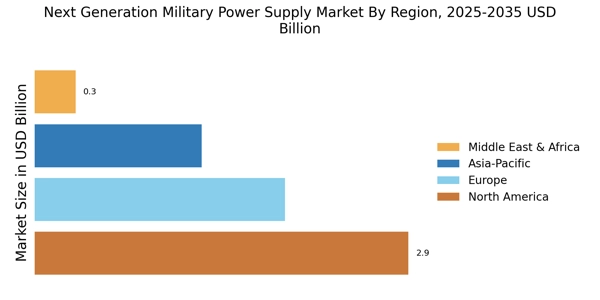Integration of Hybrid Power Solutions
The Next Generation Military Power Supply Market is seeing a notable trend towards the integration of hybrid power solutions. These systems combine traditional power sources with renewable energy technologies, such as solar and wind, to create a more sustainable and flexible power supply. The hybrid approach not only reduces dependency on fossil fuels but also enhances energy security, which is vital for military operations. Current estimates suggest that hybrid systems could reduce fuel consumption by up to 40%, making them an attractive option for defense forces. As the military sector continues to explore innovative energy solutions, the adoption of hybrid power systems is likely to gain momentum.
Increased Demand for Energy Efficiency
The Next Generation Military Power Supply Market is witnessing a pronounced shift towards energy efficiency. Military operations increasingly require power systems that not only deliver high performance but also minimize energy consumption. This demand is driven by the need to extend operational capabilities while reducing logistical burdens associated with fuel supply. Reports indicate that energy-efficient power systems can reduce operational costs by up to 30%, making them a priority for military procurement. As defense budgets tighten, the emphasis on energy efficiency is likely to shape the development of next-generation power supplies, pushing manufacturers to innovate and provide solutions that meet these stringent requirements.
Growing Focus on Resilience and Reliability
The Next Generation Military Power Supply Market is increasingly prioritizing resilience and reliability in power supply systems. Military operations often occur in unpredictable environments where power supply interruptions can have dire consequences. As a result, there is a strong emphasis on developing power systems that can withstand harsh conditions and provide uninterrupted service. This focus is reflected in the increasing investment in ruggedized power supply solutions, which are designed to operate effectively in extreme temperatures and adverse weather. The market for such resilient systems is projected to expand significantly, as militaries recognize the critical importance of reliable power in maintaining operational readiness.
Emergence of Advanced Power Management Systems
The Next Generation Military Power Supply Market is experiencing a surge in the development of advanced power management systems. These systems are designed to optimize the distribution and utilization of power across various military platforms, enhancing operational effectiveness. The integration of smart technologies allows for real-time monitoring and control of power usage, which is crucial in mission-critical scenarios. It is estimated that the adoption of such systems could lead to a 25% increase in power efficiency. As militaries seek to modernize their fleets and equipment, the demand for sophisticated power management solutions is expected to grow, driving innovation within the industry.
Regulatory and Environmental Compliance Pressures
The Next Generation Military Power Supply Market is increasingly influenced by regulatory and environmental compliance pressures. Governments are imposing stricter regulations regarding emissions and environmental impact, compelling military organizations to adopt cleaner and more sustainable power solutions. This shift is prompting manufacturers to innovate and develop power supply systems that not only meet operational requirements but also adhere to environmental standards. The market is expected to see a rise in demand for eco-friendly power solutions, as militaries strive to align with global sustainability goals. Compliance with these regulations is becoming a key driver for investment in next-generation power supply technologies.


















Leave a Comment